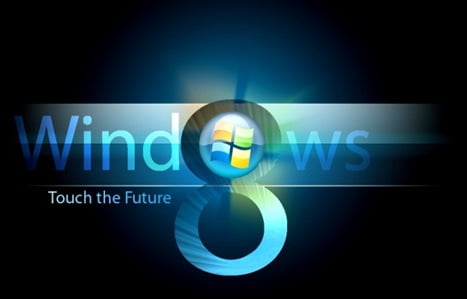Microsoft demonstrated the next generation of Windows, internally code-named “Windows 8,” for the first time at the D9 Conference. Windows 8 is a reimagining of Windows, from the chip to the interface. A Windows 8-based PC is really a new kind of device, one that scales from touch-only small screens through to large screens, with or without a keyboard and mouse.

A Few Revealed Features Of Windows 8
- Lock Screen Looks like Windows Phone 7
- Start menu is replaced by the new start screen with live application tiles.
- An updated task manager: Modern Task Manager
- The (Dreaded) Office Ribbon Returns.
- The Cloud: Sync & Share.
- “Hybrid Boot” option that uses “advanced hibernation functionality” on shutdown to allow faster startup times.
- Ability to create Portable Workspace: An installation of Windows 8 on a USB storage device.
- Xbox Integration: Kinect, A New Windows Gaming Experience.
- 128-Bits of Power: New architecture, supports more memory.
- The Tablet Hardware: Windows 8 will also operate on the ARM microchip architecture.
The demo showed some of the ways Microsoft reimagined the interface for a new generation of touch-centric hardware. Fast, fluid and dynamic, the experience has been transformed while keeping the power, flexibility and connectivity of Windows intact.
A few aspects of the new interface
- Fast launching of apps from a tile-based Start screen, which replaces the Windows Start menu with a customizable, scalable full-screen view of apps.
- Live tiles with notifications, showing always up-to-date information from your apps.
- Fluid, natural switching between running apps.
- Convenient ability to snap and resize an app to the side of the screen, so you can really multitask using the capabilities of Windows.
- Web-connected and Web-powered apps built using HTML5 and JavaScript that have access to the full power of the PC.
- Fully touch-optimized browsing, with all the power of hardware-accelerated Internet Explorer 10.
Microsoft also showed effortless movement between existing Windows programs and new Windows 8 apps. The full capabilities of Windows will be retained, including the Windows Explorer and Desktop, as does compatibility with all Windows 7 logo PCs, software and peripherals.
Although the new user interface is designed and optimized for touch, it works equally well with a mouse and keyboard. Microsoft’s approach means no compromises — we get to use whatever kind of device we prefer, with peripherals we choose, to run the apps we love. This is sure to inspire a new generation of hardware and software development, improving the experience for PC users around the world.
Microsoft also revealed a little info about how developers will be building apps for the new system. Windows 8 apps use the power of HTML5, tapping into the native capabilities of Windows using standard JavaScript and HTML to deliver new kinds of experiences. These new Windows 8 apps are full-screen and touch-optimized, and they easily integrate with the capabilities of the new Windows user interface. There’s much more to the platform, capabilities and tools than revealed.
Microsoft is excited to bring an innovative new platform and tools to developers and see how their creativity jumpstarts a new generation of apps. Windows 8 apps can use a broad set of new libraries and controls, designed for fluid interaction and seamless connectivity. Apps can add new capabilities to Windows and to other apps, connecting with one another through the new interface. Microsoft also demonstrated how a developer can extend the file picker control to enable picking from their own app content or from within another Windows 8 app, in addition to the local file system and the network.
And this isn’t just about touch PCs. The new Windows experience will ultimately be powered by application and device developers around the world — one experience across a tremendous variety of PCs. The user interface and new apps will work with or without a keyboard and mouse on a broad range of screen sizes and pixel densities, from small slates to laptops, desktops, all-in-ones, and even classroom-sized displays. Hundreds of millions of PCs will run the new Windows 8 user interface. This breadth of hardware choice is unique to Windows.
The video below introduces a few of the basic elements of the new user interface.
http://www.youtube.com/watch?v=p92QfWOw88IWindows 8 Video Demonstration – Computex 2011
http://www.youtube.com/watch?v=WDry3QUllYk
A video demonstrating for the first time the new Windows 8 touch interface. The 32 minute video was shot at the Computex 2011 in Taiwan. The presenter is Mike Angiulo, Microsoft corporate vice president. Credits:ghacks.net
The Windows 8 will be running on System on a Chip (SoC) processors. Lots of changes were made to the browser engine and they’ve significantly increased standards support in Internet Explorer 10. Windows 8 extends these innovations and reimagines every level of the Windows architecture — the kernel, networking, storage, devices, user interface — all building on the broadest and richest ecosystem of software, peripherals and devices.
Windows 8 is still under construction and so lots of cool innovation are expected in the final build. Microsoft has not yet said when Windows 8 will appear on the market. CEO Steve Ballmer dropped the year 2012 for Windows 8’s release, but Microsoft spokespersons later characterized his comment as a “misstatement.” Epps suggested that if Microsoft can get Windows 8 to market in 2012, it will “stave off defection from OEM partners to alternative operating systems, and from consumers and enterprises tempted by Apple’s platform.”
Microsoft will cover more of the new features and improvements in Windows 8 at the new BUILD developer conference, September 13-16, 2011 in Anaheim, CA. For a summary thus far, check out this Microsoft blog. Information on Microsoft’s new upcoming Build conference for developers can be found here, where registration is currently open.
Source: Microsoft Blogs.
Disclaimer: We cannot guarantee that the info is flawless.


